Leadership in the Age of Uncertainty: A Critical Literature Review
VerifiedAdded on 2023/06/10
|11
|3448
|427
Report
AI Summary
This report offers a comprehensive critical literature review of 21st-century leadership, delving into the evolution of leadership in an age of uncertainty. It begins with an introduction to the topic, exploring definitions and viewpoints from various authors, followed by an in-depth literature review that analyzes key leadership theories and competencies. The report highlights the essential skills for modern leaders, including the ability to motivate and inspire, demonstrate integrity, solve problems, communicate effectively, build relationships, innovate, shape corporate culture, and operate globally. A key component of the report is the comparison between 21st-century leadership capabilities and traditional leadership styles. The report concludes with a synthesis of the discussed concepts and recommendations for future leadership practices. The report also presents the key competencies required for leaders to succeed in the contemporary business environment and the importance of adapting to the changing needs of organizations.
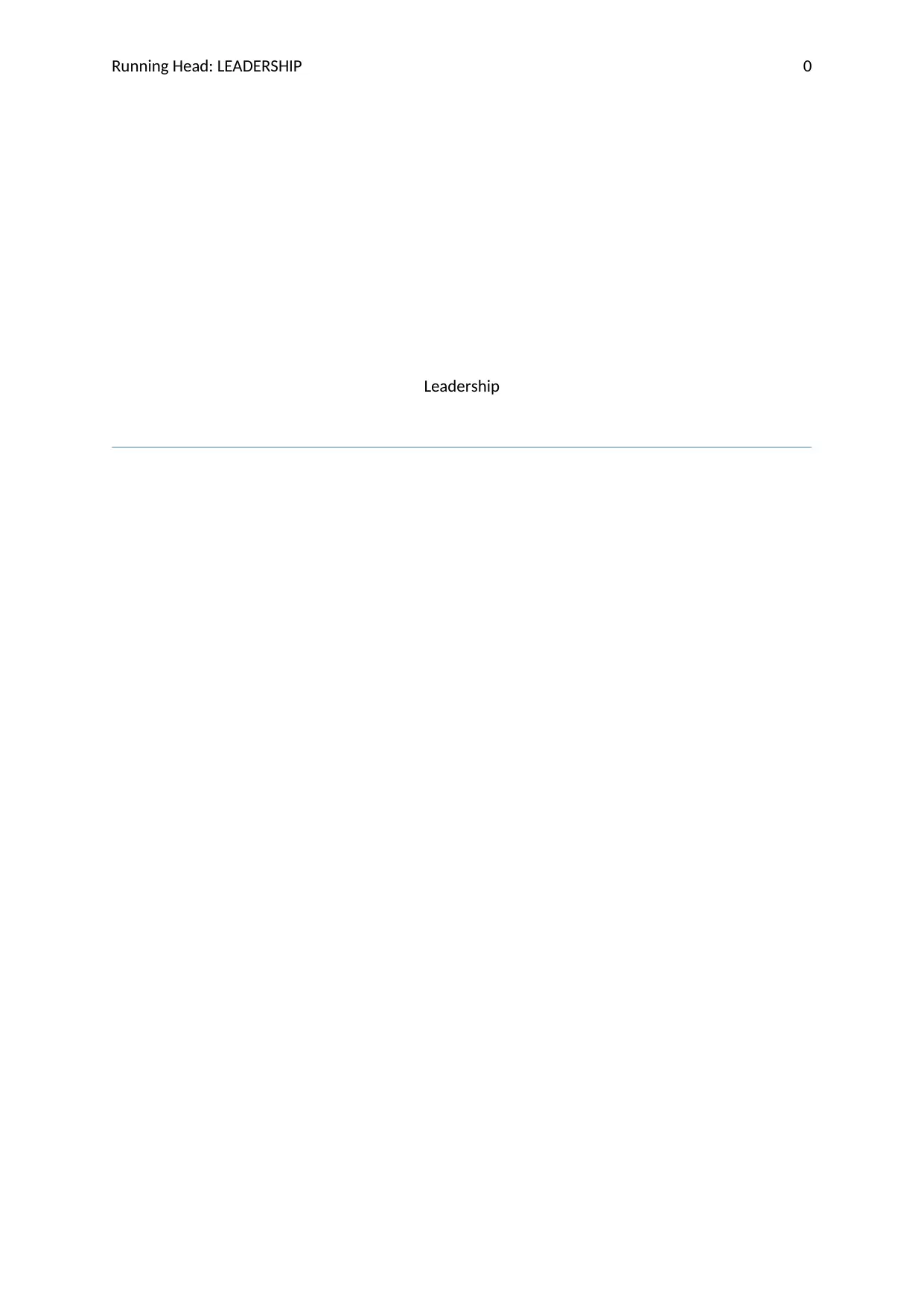
Running Head: LEADERSHIP 0
Leadership
Leadership
Paraphrase This Document
Need a fresh take? Get an instant paraphrase of this document with our AI Paraphraser
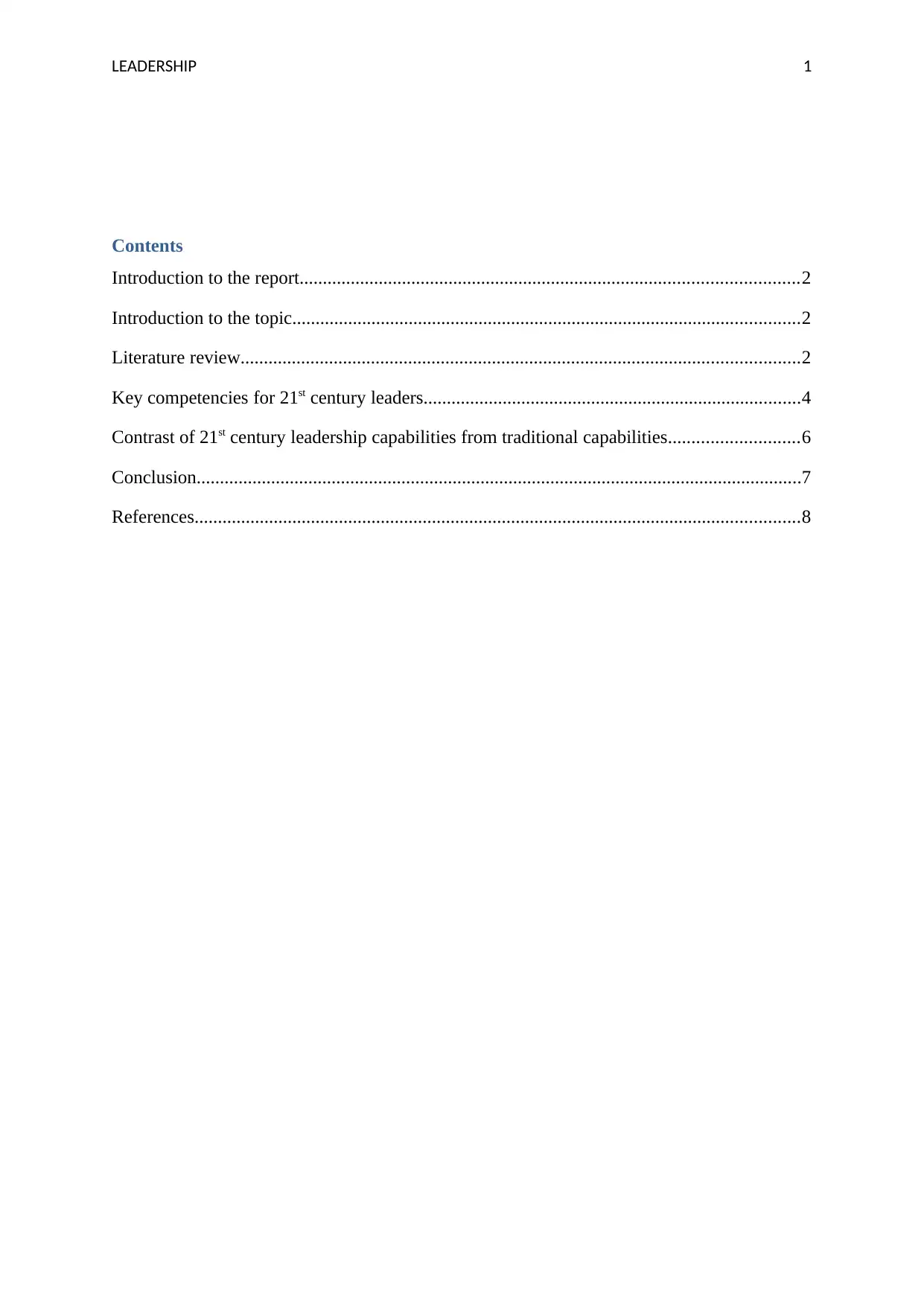
LEADERSHIP 1
Contents
Introduction to the report...........................................................................................................2
Introduction to the topic.............................................................................................................2
Literature review........................................................................................................................2
Key competencies for 21st century leaders.................................................................................4
Contrast of 21st century leadership capabilities from traditional capabilities............................6
Conclusion..................................................................................................................................7
References..................................................................................................................................8
Contents
Introduction to the report...........................................................................................................2
Introduction to the topic.............................................................................................................2
Literature review........................................................................................................................2
Key competencies for 21st century leaders.................................................................................4
Contrast of 21st century leadership capabilities from traditional capabilities............................6
Conclusion..................................................................................................................................7
References..................................................................................................................................8
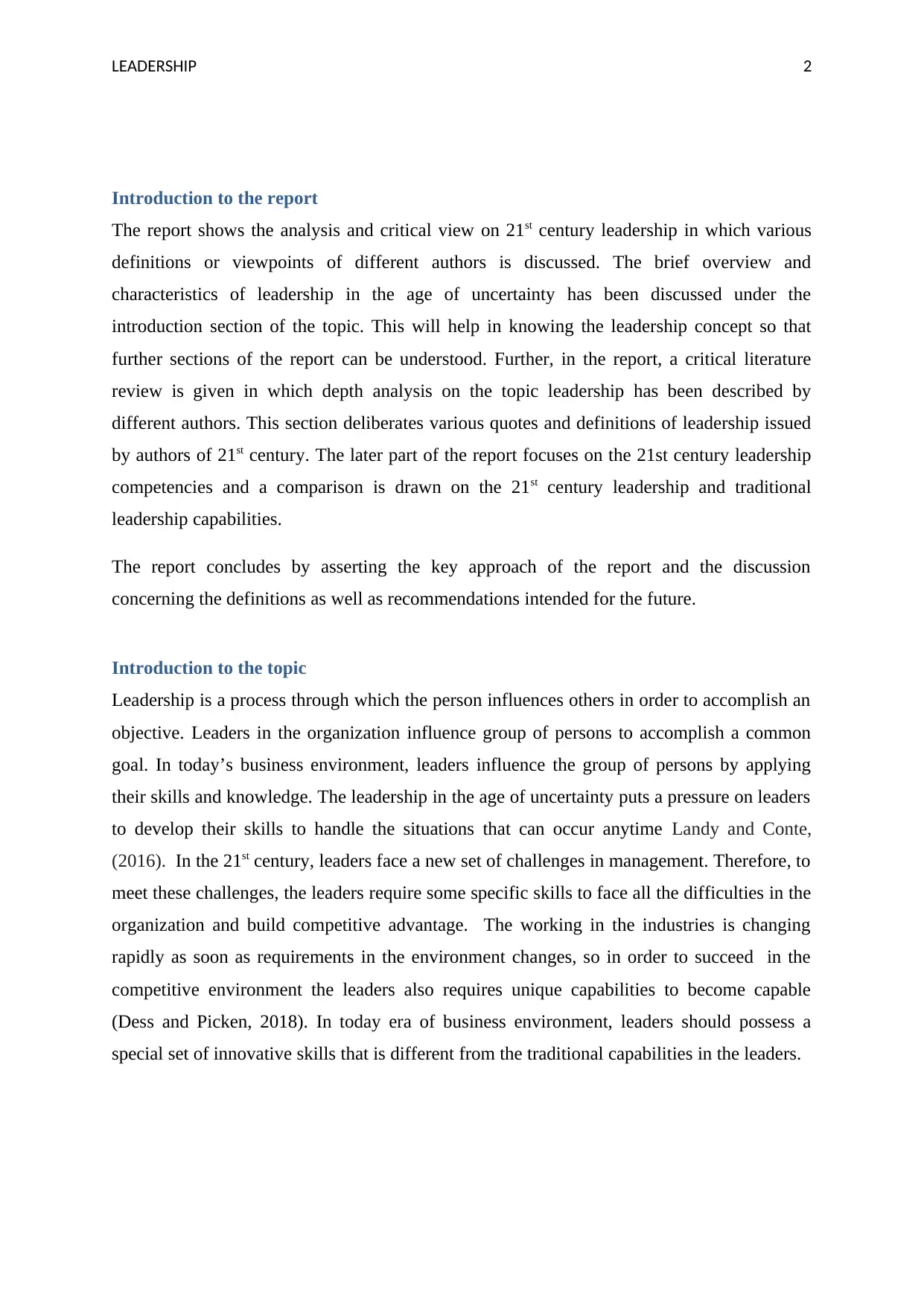
LEADERSHIP 2
Introduction to the report
The report shows the analysis and critical view on 21st century leadership in which various
definitions or viewpoints of different authors is discussed. The brief overview and
characteristics of leadership in the age of uncertainty has been discussed under the
introduction section of the topic. This will help in knowing the leadership concept so that
further sections of the report can be understood. Further, in the report, a critical literature
review is given in which depth analysis on the topic leadership has been described by
different authors. This section deliberates various quotes and definitions of leadership issued
by authors of 21st century. The later part of the report focuses on the 21st century leadership
competencies and a comparison is drawn on the 21st century leadership and traditional
leadership capabilities.
The report concludes by asserting the key approach of the report and the discussion
concerning the definitions as well as recommendations intended for the future.
Introduction to the topic
Leadership is a process through which the person influences others in order to accomplish an
objective. Leaders in the organization influence group of persons to accomplish a common
goal. In today’s business environment, leaders influence the group of persons by applying
their skills and knowledge. The leadership in the age of uncertainty puts a pressure on leaders
to develop their skills to handle the situations that can occur anytime Landy and Conte,
(2016). In the 21st century, leaders face a new set of challenges in management. Therefore, to
meet these challenges, the leaders require some specific skills to face all the difficulties in the
organization and build competitive advantage. The working in the industries is changing
rapidly as soon as requirements in the environment changes, so in order to succeed in the
competitive environment the leaders also requires unique capabilities to become capable
(Dess and Picken, 2018). In today era of business environment, leaders should possess a
special set of innovative skills that is different from the traditional capabilities in the leaders.
Introduction to the report
The report shows the analysis and critical view on 21st century leadership in which various
definitions or viewpoints of different authors is discussed. The brief overview and
characteristics of leadership in the age of uncertainty has been discussed under the
introduction section of the topic. This will help in knowing the leadership concept so that
further sections of the report can be understood. Further, in the report, a critical literature
review is given in which depth analysis on the topic leadership has been described by
different authors. This section deliberates various quotes and definitions of leadership issued
by authors of 21st century. The later part of the report focuses on the 21st century leadership
competencies and a comparison is drawn on the 21st century leadership and traditional
leadership capabilities.
The report concludes by asserting the key approach of the report and the discussion
concerning the definitions as well as recommendations intended for the future.
Introduction to the topic
Leadership is a process through which the person influences others in order to accomplish an
objective. Leaders in the organization influence group of persons to accomplish a common
goal. In today’s business environment, leaders influence the group of persons by applying
their skills and knowledge. The leadership in the age of uncertainty puts a pressure on leaders
to develop their skills to handle the situations that can occur anytime Landy and Conte,
(2016). In the 21st century, leaders face a new set of challenges in management. Therefore, to
meet these challenges, the leaders require some specific skills to face all the difficulties in the
organization and build competitive advantage. The working in the industries is changing
rapidly as soon as requirements in the environment changes, so in order to succeed in the
competitive environment the leaders also requires unique capabilities to become capable
(Dess and Picken, 2018). In today era of business environment, leaders should possess a
special set of innovative skills that is different from the traditional capabilities in the leaders.
⊘ This is a preview!⊘
Do you want full access?
Subscribe today to unlock all pages.

Trusted by 1+ million students worldwide
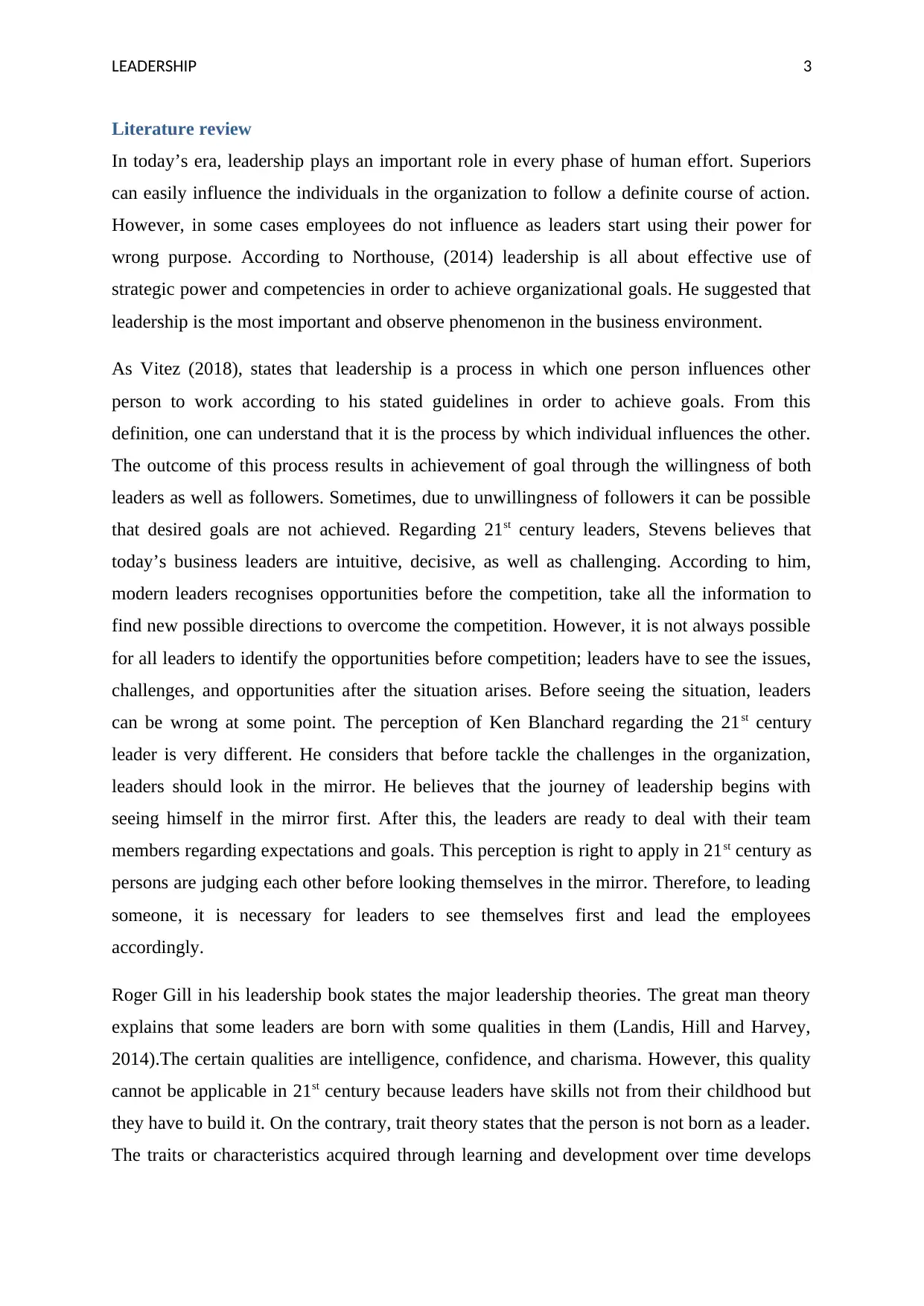
LEADERSHIP 3
Literature review
In today’s era, leadership plays an important role in every phase of human effort. Superiors
can easily influence the individuals in the organization to follow a definite course of action.
However, in some cases employees do not influence as leaders start using their power for
wrong purpose. According to Northouse, (2014) leadership is all about effective use of
strategic power and competencies in order to achieve organizational goals. He suggested that
leadership is the most important and observe phenomenon in the business environment.
As Vitez (2018), states that leadership is a process in which one person influences other
person to work according to his stated guidelines in order to achieve goals. From this
definition, one can understand that it is the process by which individual influences the other.
The outcome of this process results in achievement of goal through the willingness of both
leaders as well as followers. Sometimes, due to unwillingness of followers it can be possible
that desired goals are not achieved. Regarding 21st century leaders, Stevens believes that
today’s business leaders are intuitive, decisive, as well as challenging. According to him,
modern leaders recognises opportunities before the competition, take all the information to
find new possible directions to overcome the competition. However, it is not always possible
for all leaders to identify the opportunities before competition; leaders have to see the issues,
challenges, and opportunities after the situation arises. Before seeing the situation, leaders
can be wrong at some point. The perception of Ken Blanchard regarding the 21st century
leader is very different. He considers that before tackle the challenges in the organization,
leaders should look in the mirror. He believes that the journey of leadership begins with
seeing himself in the mirror first. After this, the leaders are ready to deal with their team
members regarding expectations and goals. This perception is right to apply in 21st century as
persons are judging each other before looking themselves in the mirror. Therefore, to leading
someone, it is necessary for leaders to see themselves first and lead the employees
accordingly.
Roger Gill in his leadership book states the major leadership theories. The great man theory
explains that some leaders are born with some qualities in them (Landis, Hill and Harvey,
2014).The certain qualities are intelligence, confidence, and charisma. However, this quality
cannot be applicable in 21st century because leaders have skills not from their childhood but
they have to build it. On the contrary, trait theory states that the person is not born as a leader.
The traits or characteristics acquired through learning and development over time develops
Literature review
In today’s era, leadership plays an important role in every phase of human effort. Superiors
can easily influence the individuals in the organization to follow a definite course of action.
However, in some cases employees do not influence as leaders start using their power for
wrong purpose. According to Northouse, (2014) leadership is all about effective use of
strategic power and competencies in order to achieve organizational goals. He suggested that
leadership is the most important and observe phenomenon in the business environment.
As Vitez (2018), states that leadership is a process in which one person influences other
person to work according to his stated guidelines in order to achieve goals. From this
definition, one can understand that it is the process by which individual influences the other.
The outcome of this process results in achievement of goal through the willingness of both
leaders as well as followers. Sometimes, due to unwillingness of followers it can be possible
that desired goals are not achieved. Regarding 21st century leaders, Stevens believes that
today’s business leaders are intuitive, decisive, as well as challenging. According to him,
modern leaders recognises opportunities before the competition, take all the information to
find new possible directions to overcome the competition. However, it is not always possible
for all leaders to identify the opportunities before competition; leaders have to see the issues,
challenges, and opportunities after the situation arises. Before seeing the situation, leaders
can be wrong at some point. The perception of Ken Blanchard regarding the 21st century
leader is very different. He considers that before tackle the challenges in the organization,
leaders should look in the mirror. He believes that the journey of leadership begins with
seeing himself in the mirror first. After this, the leaders are ready to deal with their team
members regarding expectations and goals. This perception is right to apply in 21st century as
persons are judging each other before looking themselves in the mirror. Therefore, to leading
someone, it is necessary for leaders to see themselves first and lead the employees
accordingly.
Roger Gill in his leadership book states the major leadership theories. The great man theory
explains that some leaders are born with some qualities in them (Landis, Hill and Harvey,
2014).The certain qualities are intelligence, confidence, and charisma. However, this quality
cannot be applicable in 21st century because leaders have skills not from their childhood but
they have to build it. On the contrary, trait theory states that the person is not born as a leader.
The traits or characteristics acquired through learning and development over time develops
Paraphrase This Document
Need a fresh take? Get an instant paraphrase of this document with our AI Paraphraser
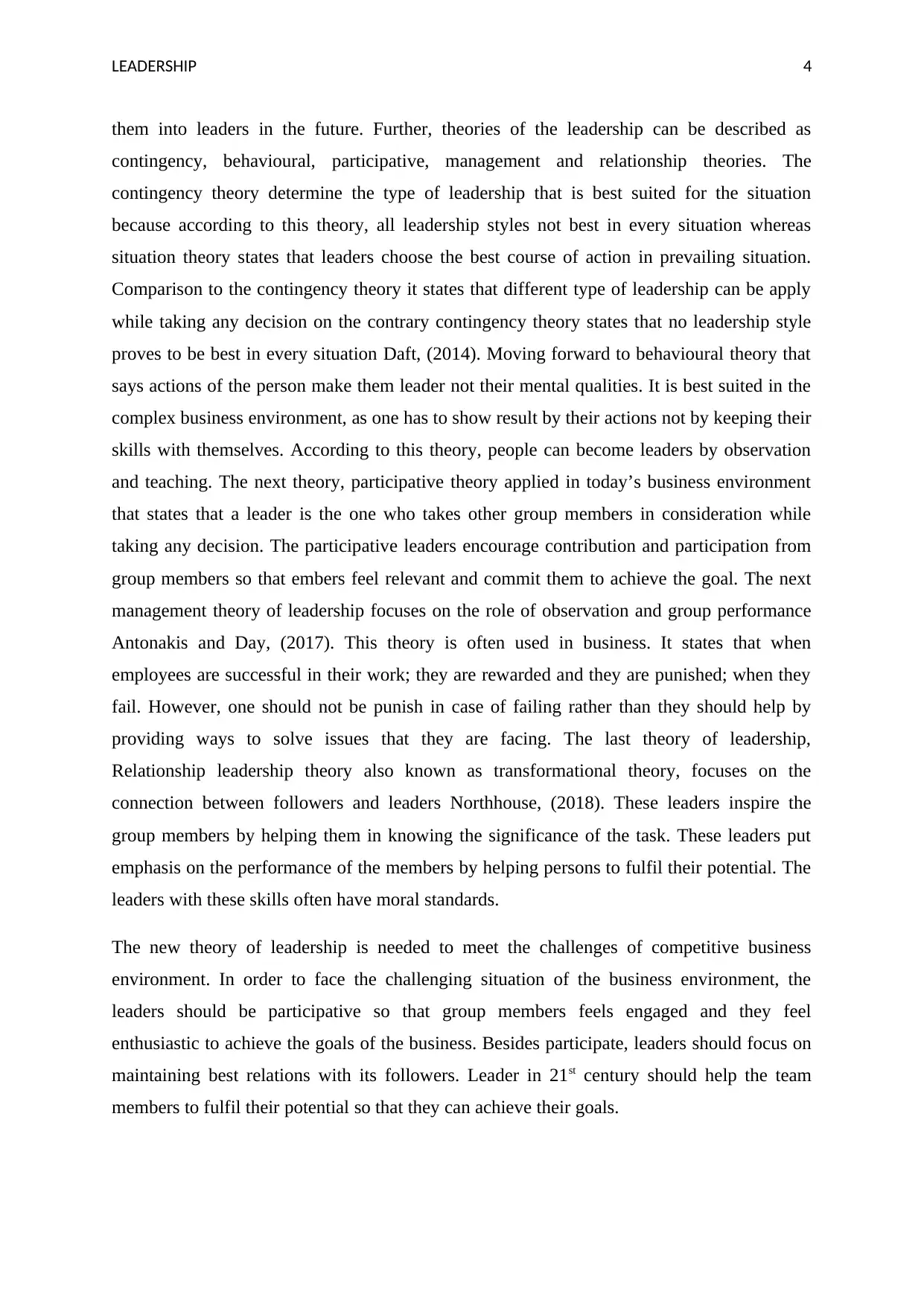
LEADERSHIP 4
them into leaders in the future. Further, theories of the leadership can be described as
contingency, behavioural, participative, management and relationship theories. The
contingency theory determine the type of leadership that is best suited for the situation
because according to this theory, all leadership styles not best in every situation whereas
situation theory states that leaders choose the best course of action in prevailing situation.
Comparison to the contingency theory it states that different type of leadership can be apply
while taking any decision on the contrary contingency theory states that no leadership style
proves to be best in every situation Daft, (2014). Moving forward to behavioural theory that
says actions of the person make them leader not their mental qualities. It is best suited in the
complex business environment, as one has to show result by their actions not by keeping their
skills with themselves. According to this theory, people can become leaders by observation
and teaching. The next theory, participative theory applied in today’s business environment
that states that a leader is the one who takes other group members in consideration while
taking any decision. The participative leaders encourage contribution and participation from
group members so that embers feel relevant and commit them to achieve the goal. The next
management theory of leadership focuses on the role of observation and group performance
Antonakis and Day, (2017). This theory is often used in business. It states that when
employees are successful in their work; they are rewarded and they are punished; when they
fail. However, one should not be punish in case of failing rather than they should help by
providing ways to solve issues that they are facing. The last theory of leadership,
Relationship leadership theory also known as transformational theory, focuses on the
connection between followers and leaders Northhouse, (2018). These leaders inspire the
group members by helping them in knowing the significance of the task. These leaders put
emphasis on the performance of the members by helping persons to fulfil their potential. The
leaders with these skills often have moral standards.
The new theory of leadership is needed to meet the challenges of competitive business
environment. In order to face the challenging situation of the business environment, the
leaders should be participative so that group members feels engaged and they feel
enthusiastic to achieve the goals of the business. Besides participate, leaders should focus on
maintaining best relations with its followers. Leader in 21st century should help the team
members to fulfil their potential so that they can achieve their goals.
them into leaders in the future. Further, theories of the leadership can be described as
contingency, behavioural, participative, management and relationship theories. The
contingency theory determine the type of leadership that is best suited for the situation
because according to this theory, all leadership styles not best in every situation whereas
situation theory states that leaders choose the best course of action in prevailing situation.
Comparison to the contingency theory it states that different type of leadership can be apply
while taking any decision on the contrary contingency theory states that no leadership style
proves to be best in every situation Daft, (2014). Moving forward to behavioural theory that
says actions of the person make them leader not their mental qualities. It is best suited in the
complex business environment, as one has to show result by their actions not by keeping their
skills with themselves. According to this theory, people can become leaders by observation
and teaching. The next theory, participative theory applied in today’s business environment
that states that a leader is the one who takes other group members in consideration while
taking any decision. The participative leaders encourage contribution and participation from
group members so that embers feel relevant and commit them to achieve the goal. The next
management theory of leadership focuses on the role of observation and group performance
Antonakis and Day, (2017). This theory is often used in business. It states that when
employees are successful in their work; they are rewarded and they are punished; when they
fail. However, one should not be punish in case of failing rather than they should help by
providing ways to solve issues that they are facing. The last theory of leadership,
Relationship leadership theory also known as transformational theory, focuses on the
connection between followers and leaders Northhouse, (2018). These leaders inspire the
group members by helping them in knowing the significance of the task. These leaders put
emphasis on the performance of the members by helping persons to fulfil their potential. The
leaders with these skills often have moral standards.
The new theory of leadership is needed to meet the challenges of competitive business
environment. In order to face the challenging situation of the business environment, the
leaders should be participative so that group members feels engaged and they feel
enthusiastic to achieve the goals of the business. Besides participate, leaders should focus on
maintaining best relations with its followers. Leader in 21st century should help the team
members to fulfil their potential so that they can achieve their goals.
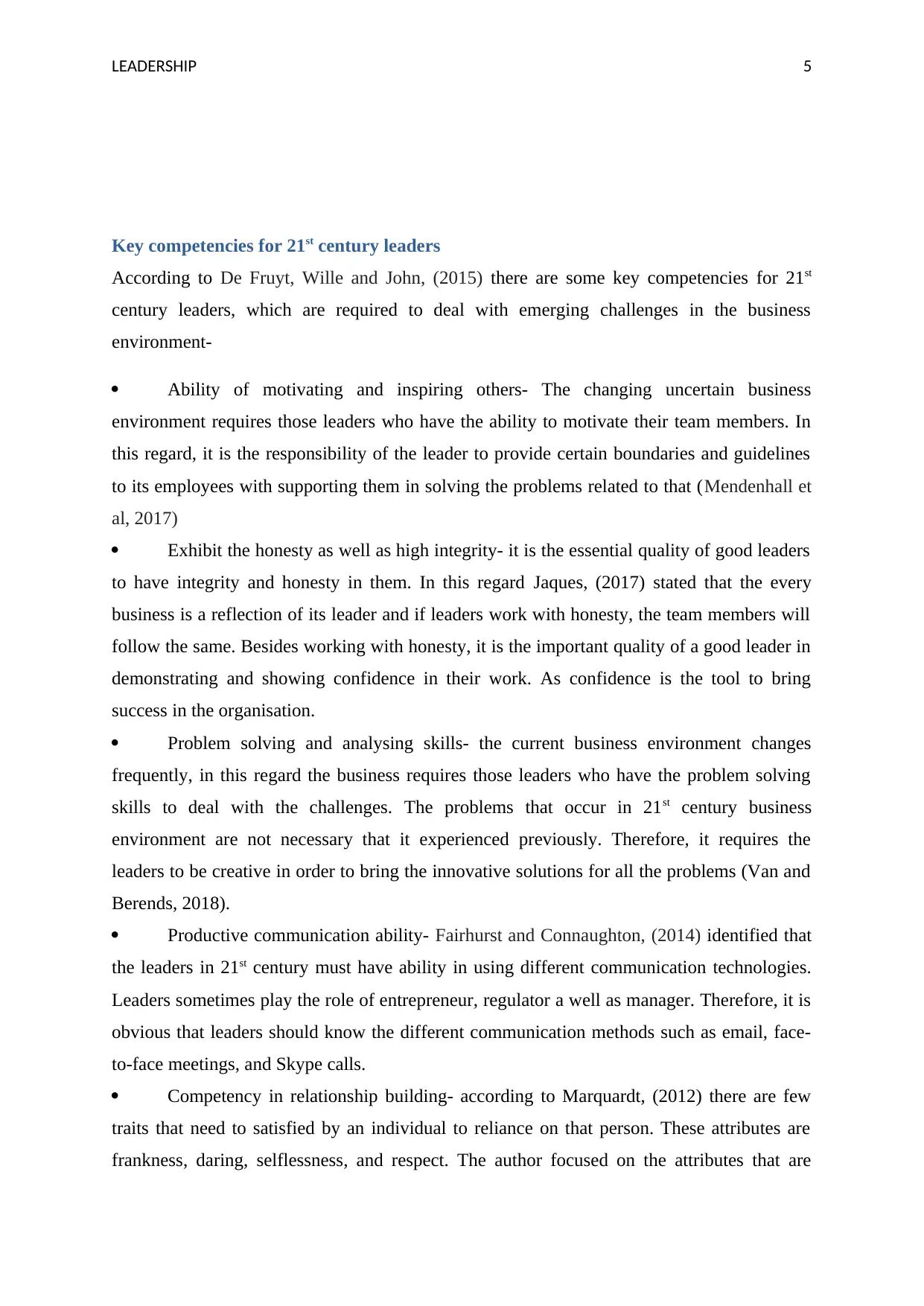
LEADERSHIP 5
Key competencies for 21st century leaders
According to De Fruyt, Wille and John, (2015) there are some key competencies for 21st
century leaders, which are required to deal with emerging challenges in the business
environment-
Ability of motivating and inspiring others- The changing uncertain business
environment requires those leaders who have the ability to motivate their team members. In
this regard, it is the responsibility of the leader to provide certain boundaries and guidelines
to its employees with supporting them in solving the problems related to that (Mendenhall et
al, 2017)
Exhibit the honesty as well as high integrity- it is the essential quality of good leaders
to have integrity and honesty in them. In this regard Jaques, (2017) stated that the every
business is a reflection of its leader and if leaders work with honesty, the team members will
follow the same. Besides working with honesty, it is the important quality of a good leader in
demonstrating and showing confidence in their work. As confidence is the tool to bring
success in the organisation.
Problem solving and analysing skills- the current business environment changes
frequently, in this regard the business requires those leaders who have the problem solving
skills to deal with the challenges. The problems that occur in 21st century business
environment are not necessary that it experienced previously. Therefore, it requires the
leaders to be creative in order to bring the innovative solutions for all the problems (Van and
Berends, 2018).
Productive communication ability- Fairhurst and Connaughton, (2014) identified that
the leaders in 21st century must have ability in using different communication technologies.
Leaders sometimes play the role of entrepreneur, regulator a well as manager. Therefore, it is
obvious that leaders should know the different communication methods such as email, face-
to-face meetings, and Skype calls.
Competency in relationship building- according to Marquardt, (2012) there are few
traits that need to satisfied by an individual to reliance on that person. These attributes are
frankness, daring, selflessness, and respect. The author focused on the attributes that are
Key competencies for 21st century leaders
According to De Fruyt, Wille and John, (2015) there are some key competencies for 21st
century leaders, which are required to deal with emerging challenges in the business
environment-
Ability of motivating and inspiring others- The changing uncertain business
environment requires those leaders who have the ability to motivate their team members. In
this regard, it is the responsibility of the leader to provide certain boundaries and guidelines
to its employees with supporting them in solving the problems related to that (Mendenhall et
al, 2017)
Exhibit the honesty as well as high integrity- it is the essential quality of good leaders
to have integrity and honesty in them. In this regard Jaques, (2017) stated that the every
business is a reflection of its leader and if leaders work with honesty, the team members will
follow the same. Besides working with honesty, it is the important quality of a good leader in
demonstrating and showing confidence in their work. As confidence is the tool to bring
success in the organisation.
Problem solving and analysing skills- the current business environment changes
frequently, in this regard the business requires those leaders who have the problem solving
skills to deal with the challenges. The problems that occur in 21st century business
environment are not necessary that it experienced previously. Therefore, it requires the
leaders to be creative in order to bring the innovative solutions for all the problems (Van and
Berends, 2018).
Productive communication ability- Fairhurst and Connaughton, (2014) identified that
the leaders in 21st century must have ability in using different communication technologies.
Leaders sometimes play the role of entrepreneur, regulator a well as manager. Therefore, it is
obvious that leaders should know the different communication methods such as email, face-
to-face meetings, and Skype calls.
Competency in relationship building- according to Marquardt, (2012) there are few
traits that need to satisfied by an individual to reliance on that person. These attributes are
frankness, daring, selflessness, and respect. The author focused on the attributes that are
⊘ This is a preview!⊘
Do you want full access?
Subscribe today to unlock all pages.

Trusted by 1+ million students worldwide
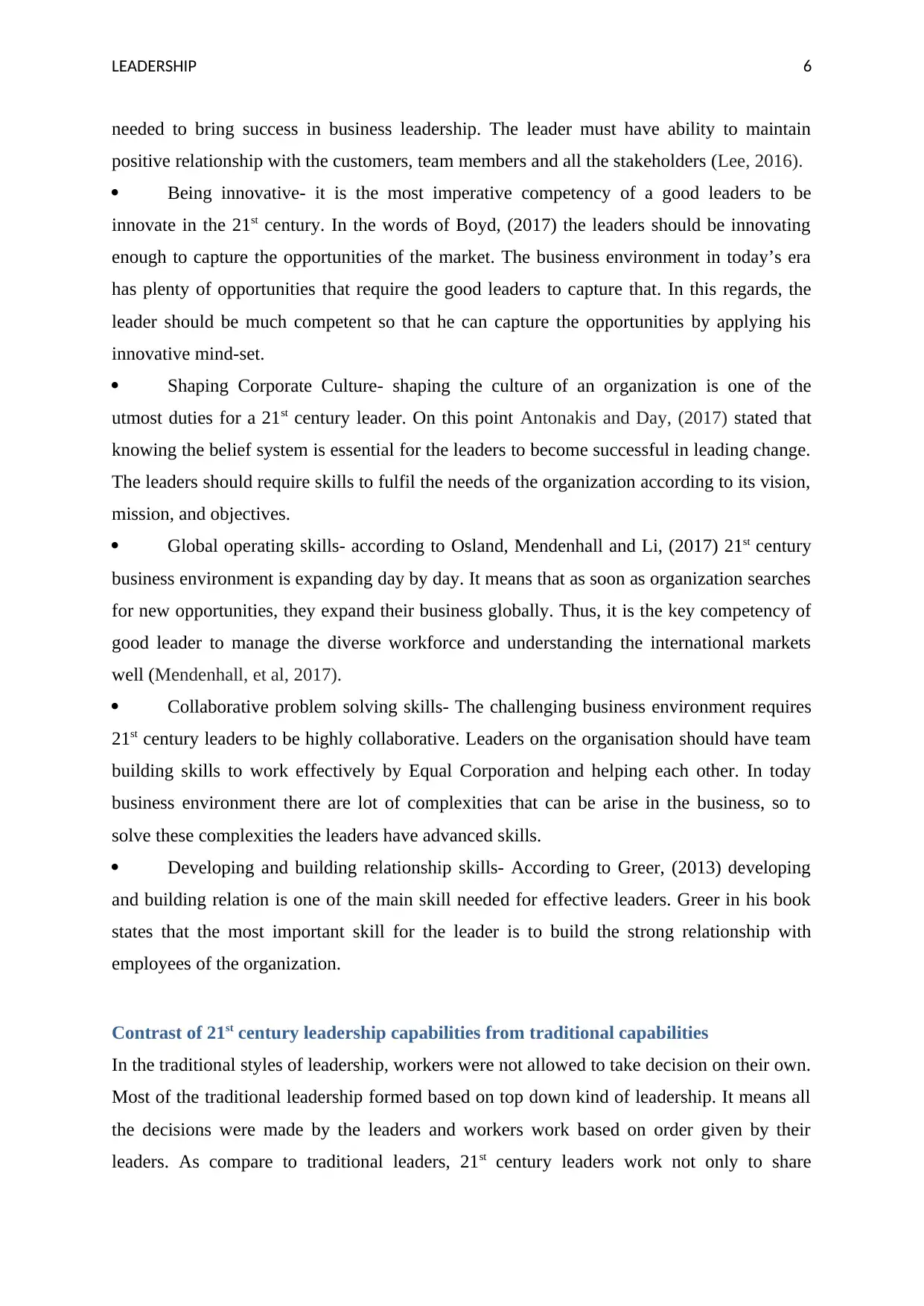
LEADERSHIP 6
needed to bring success in business leadership. The leader must have ability to maintain
positive relationship with the customers, team members and all the stakeholders (Lee, 2016).
Being innovative- it is the most imperative competency of a good leaders to be
innovate in the 21st century. In the words of Boyd, (2017) the leaders should be innovating
enough to capture the opportunities of the market. The business environment in today’s era
has plenty of opportunities that require the good leaders to capture that. In this regards, the
leader should be much competent so that he can capture the opportunities by applying his
innovative mind-set.
Shaping Corporate Culture- shaping the culture of an organization is one of the
utmost duties for a 21st century leader. On this point Antonakis and Day, (2017) stated that
knowing the belief system is essential for the leaders to become successful in leading change.
The leaders should require skills to fulfil the needs of the organization according to its vision,
mission, and objectives.
Global operating skills- according to Osland, Mendenhall and Li, (2017) 21st century
business environment is expanding day by day. It means that as soon as organization searches
for new opportunities, they expand their business globally. Thus, it is the key competency of
good leader to manage the diverse workforce and understanding the international markets
well (Mendenhall, et al, 2017).
Collaborative problem solving skills- The challenging business environment requires
21st century leaders to be highly collaborative. Leaders on the organisation should have team
building skills to work effectively by Equal Corporation and helping each other. In today
business environment there are lot of complexities that can be arise in the business, so to
solve these complexities the leaders have advanced skills.
Developing and building relationship skills- According to Greer, (2013) developing
and building relation is one of the main skill needed for effective leaders. Greer in his book
states that the most important skill for the leader is to build the strong relationship with
employees of the organization.
Contrast of 21st century leadership capabilities from traditional capabilities
In the traditional styles of leadership, workers were not allowed to take decision on their own.
Most of the traditional leadership formed based on top down kind of leadership. It means all
the decisions were made by the leaders and workers work based on order given by their
leaders. As compare to traditional leaders, 21st century leaders work not only to share
needed to bring success in business leadership. The leader must have ability to maintain
positive relationship with the customers, team members and all the stakeholders (Lee, 2016).
Being innovative- it is the most imperative competency of a good leaders to be
innovate in the 21st century. In the words of Boyd, (2017) the leaders should be innovating
enough to capture the opportunities of the market. The business environment in today’s era
has plenty of opportunities that require the good leaders to capture that. In this regards, the
leader should be much competent so that he can capture the opportunities by applying his
innovative mind-set.
Shaping Corporate Culture- shaping the culture of an organization is one of the
utmost duties for a 21st century leader. On this point Antonakis and Day, (2017) stated that
knowing the belief system is essential for the leaders to become successful in leading change.
The leaders should require skills to fulfil the needs of the organization according to its vision,
mission, and objectives.
Global operating skills- according to Osland, Mendenhall and Li, (2017) 21st century
business environment is expanding day by day. It means that as soon as organization searches
for new opportunities, they expand their business globally. Thus, it is the key competency of
good leader to manage the diverse workforce and understanding the international markets
well (Mendenhall, et al, 2017).
Collaborative problem solving skills- The challenging business environment requires
21st century leaders to be highly collaborative. Leaders on the organisation should have team
building skills to work effectively by Equal Corporation and helping each other. In today
business environment there are lot of complexities that can be arise in the business, so to
solve these complexities the leaders have advanced skills.
Developing and building relationship skills- According to Greer, (2013) developing
and building relation is one of the main skill needed for effective leaders. Greer in his book
states that the most important skill for the leader is to build the strong relationship with
employees of the organization.
Contrast of 21st century leadership capabilities from traditional capabilities
In the traditional styles of leadership, workers were not allowed to take decision on their own.
Most of the traditional leadership formed based on top down kind of leadership. It means all
the decisions were made by the leaders and workers work based on order given by their
leaders. As compare to traditional leaders, 21st century leaders work not only to share
Paraphrase This Document
Need a fresh take? Get an instant paraphrase of this document with our AI Paraphraser
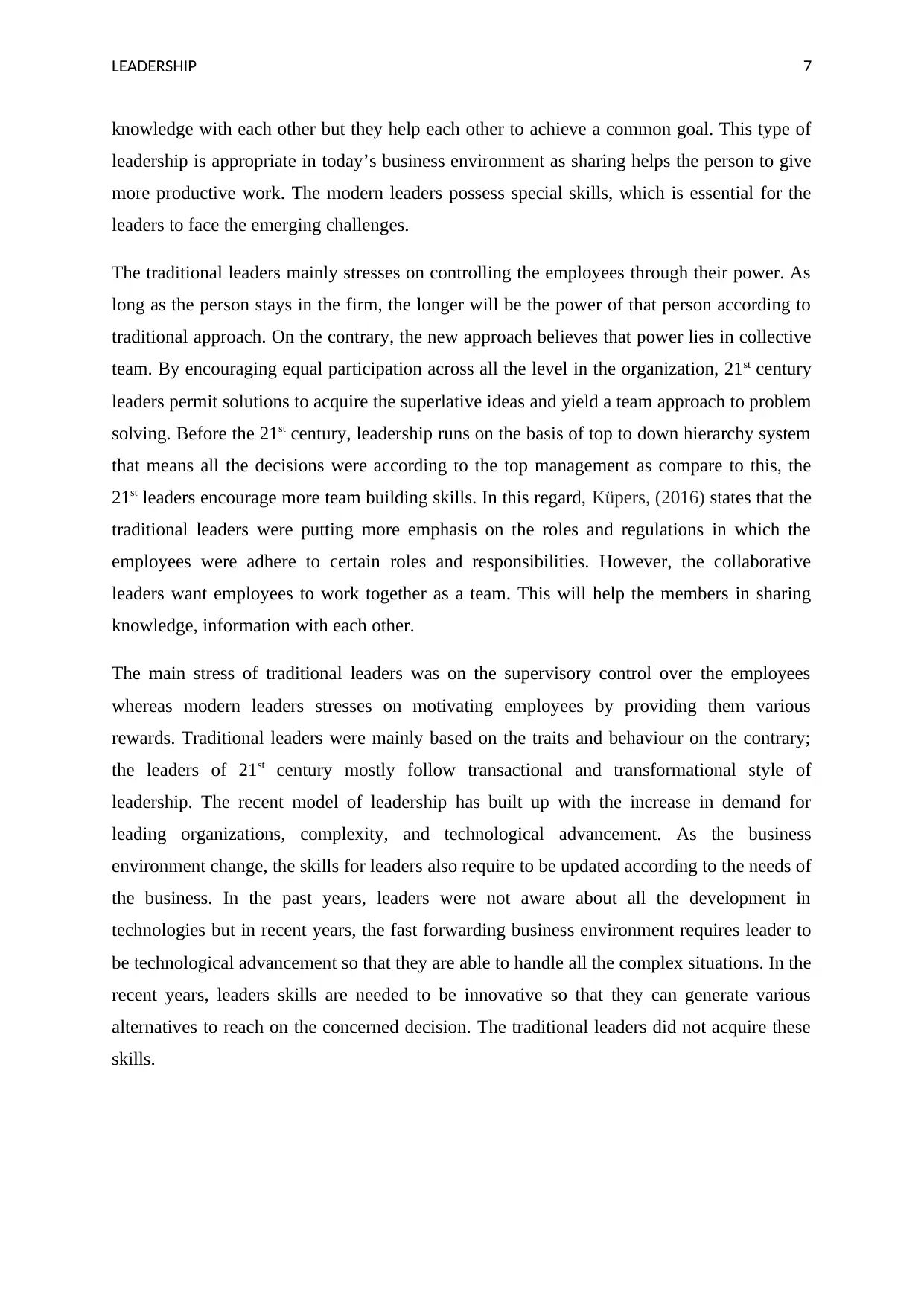
LEADERSHIP 7
knowledge with each other but they help each other to achieve a common goal. This type of
leadership is appropriate in today’s business environment as sharing helps the person to give
more productive work. The modern leaders possess special skills, which is essential for the
leaders to face the emerging challenges.
The traditional leaders mainly stresses on controlling the employees through their power. As
long as the person stays in the firm, the longer will be the power of that person according to
traditional approach. On the contrary, the new approach believes that power lies in collective
team. By encouraging equal participation across all the level in the organization, 21st century
leaders permit solutions to acquire the superlative ideas and yield a team approach to problem
solving. Before the 21st century, leadership runs on the basis of top to down hierarchy system
that means all the decisions were according to the top management as compare to this, the
21st leaders encourage more team building skills. In this regard, Küpers, (2016) states that the
traditional leaders were putting more emphasis on the roles and regulations in which the
employees were adhere to certain roles and responsibilities. However, the collaborative
leaders want employees to work together as a team. This will help the members in sharing
knowledge, information with each other.
The main stress of traditional leaders was on the supervisory control over the employees
whereas modern leaders stresses on motivating employees by providing them various
rewards. Traditional leaders were mainly based on the traits and behaviour on the contrary;
the leaders of 21st century mostly follow transactional and transformational style of
leadership. The recent model of leadership has built up with the increase in demand for
leading organizations, complexity, and technological advancement. As the business
environment change, the skills for leaders also require to be updated according to the needs of
the business. In the past years, leaders were not aware about all the development in
technologies but in recent years, the fast forwarding business environment requires leader to
be technological advancement so that they are able to handle all the complex situations. In the
recent years, leaders skills are needed to be innovative so that they can generate various
alternatives to reach on the concerned decision. The traditional leaders did not acquire these
skills.
knowledge with each other but they help each other to achieve a common goal. This type of
leadership is appropriate in today’s business environment as sharing helps the person to give
more productive work. The modern leaders possess special skills, which is essential for the
leaders to face the emerging challenges.
The traditional leaders mainly stresses on controlling the employees through their power. As
long as the person stays in the firm, the longer will be the power of that person according to
traditional approach. On the contrary, the new approach believes that power lies in collective
team. By encouraging equal participation across all the level in the organization, 21st century
leaders permit solutions to acquire the superlative ideas and yield a team approach to problem
solving. Before the 21st century, leadership runs on the basis of top to down hierarchy system
that means all the decisions were according to the top management as compare to this, the
21st leaders encourage more team building skills. In this regard, Küpers, (2016) states that the
traditional leaders were putting more emphasis on the roles and regulations in which the
employees were adhere to certain roles and responsibilities. However, the collaborative
leaders want employees to work together as a team. This will help the members in sharing
knowledge, information with each other.
The main stress of traditional leaders was on the supervisory control over the employees
whereas modern leaders stresses on motivating employees by providing them various
rewards. Traditional leaders were mainly based on the traits and behaviour on the contrary;
the leaders of 21st century mostly follow transactional and transformational style of
leadership. The recent model of leadership has built up with the increase in demand for
leading organizations, complexity, and technological advancement. As the business
environment change, the skills for leaders also require to be updated according to the needs of
the business. In the past years, leaders were not aware about all the development in
technologies but in recent years, the fast forwarding business environment requires leader to
be technological advancement so that they are able to handle all the complex situations. In the
recent years, leaders skills are needed to be innovative so that they can generate various
alternatives to reach on the concerned decision. The traditional leaders did not acquire these
skills.
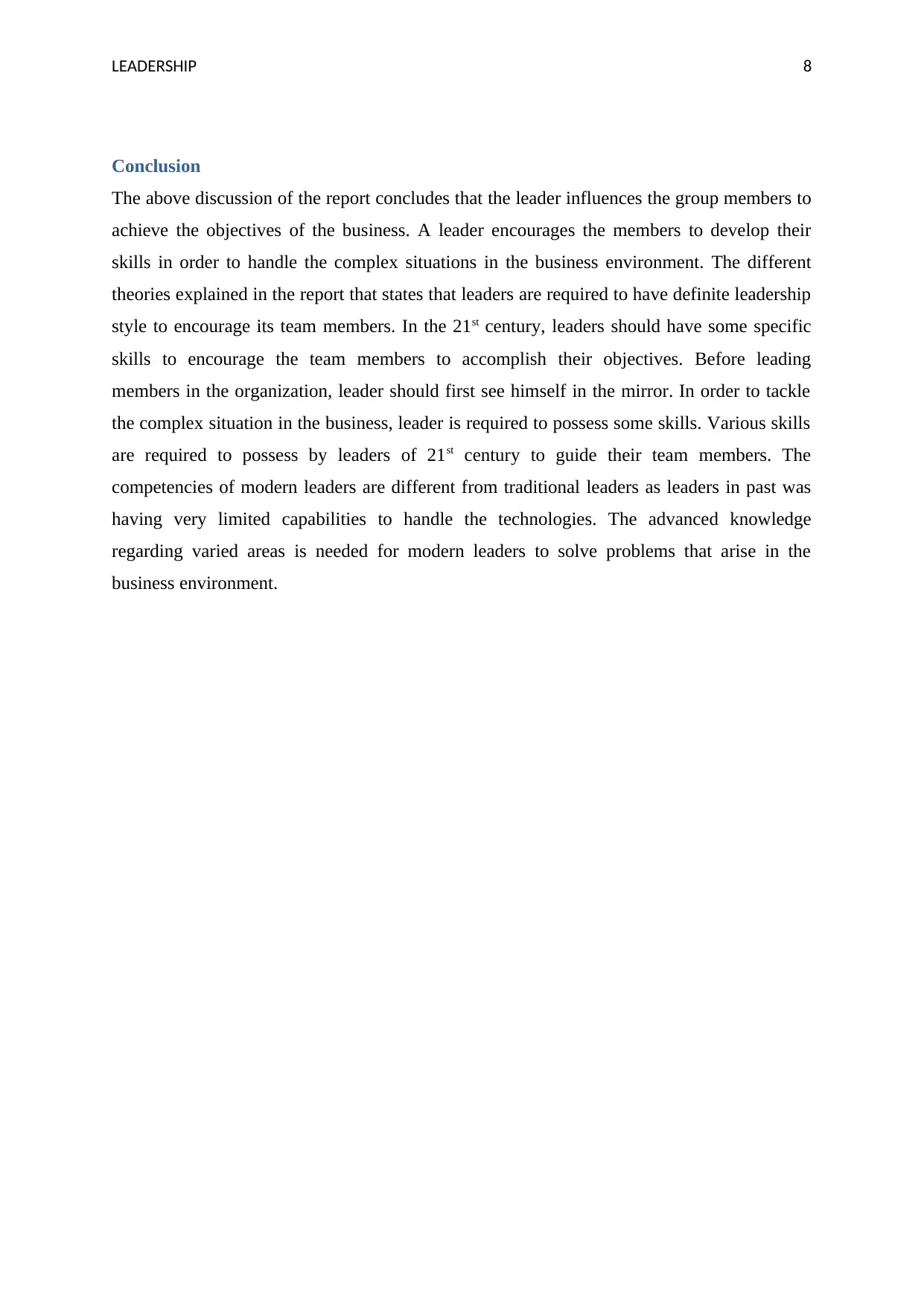
LEADERSHIP 8
Conclusion
The above discussion of the report concludes that the leader influences the group members to
achieve the objectives of the business. A leader encourages the members to develop their
skills in order to handle the complex situations in the business environment. The different
theories explained in the report that states that leaders are required to have definite leadership
style to encourage its team members. In the 21st century, leaders should have some specific
skills to encourage the team members to accomplish their objectives. Before leading
members in the organization, leader should first see himself in the mirror. In order to tackle
the complex situation in the business, leader is required to possess some skills. Various skills
are required to possess by leaders of 21st century to guide their team members. The
competencies of modern leaders are different from traditional leaders as leaders in past was
having very limited capabilities to handle the technologies. The advanced knowledge
regarding varied areas is needed for modern leaders to solve problems that arise in the
business environment.
Conclusion
The above discussion of the report concludes that the leader influences the group members to
achieve the objectives of the business. A leader encourages the members to develop their
skills in order to handle the complex situations in the business environment. The different
theories explained in the report that states that leaders are required to have definite leadership
style to encourage its team members. In the 21st century, leaders should have some specific
skills to encourage the team members to accomplish their objectives. Before leading
members in the organization, leader should first see himself in the mirror. In order to tackle
the complex situation in the business, leader is required to possess some skills. Various skills
are required to possess by leaders of 21st century to guide their team members. The
competencies of modern leaders are different from traditional leaders as leaders in past was
having very limited capabilities to handle the technologies. The advanced knowledge
regarding varied areas is needed for modern leaders to solve problems that arise in the
business environment.
⊘ This is a preview!⊘
Do you want full access?
Subscribe today to unlock all pages.

Trusted by 1+ million students worldwide
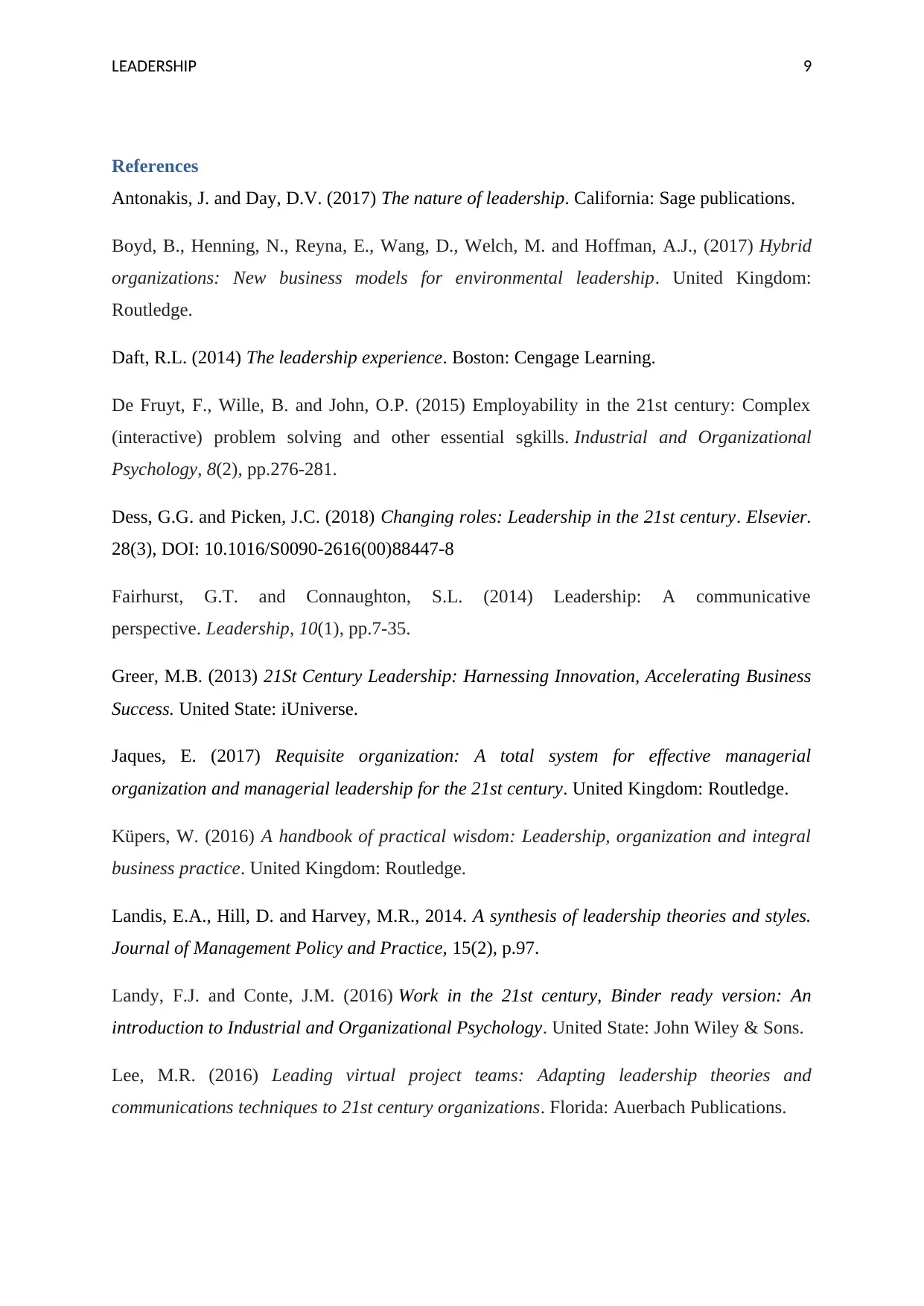
LEADERSHIP 9
References
Antonakis, J. and Day, D.V. (2017) The nature of leadership. California: Sage publications.
Boyd, B., Henning, N., Reyna, E., Wang, D., Welch, M. and Hoffman, A.J., (2017) Hybrid
organizations: New business models for environmental leadership. United Kingdom:
Routledge.
Daft, R.L. (2014) The leadership experience. Boston: Cengage Learning.
De Fruyt, F., Wille, B. and John, O.P. (2015) Employability in the 21st century: Complex
(interactive) problem solving and other essential sgkills. Industrial and Organizational
Psychology, 8(2), pp.276-281.
Dess, G.G. and Picken, J.C. (2018) Changing roles: Leadership in the 21st century. Elsevier.
28(3), DOI: 10.1016/S0090-2616(00)88447-8
Fairhurst, G.T. and Connaughton, S.L. (2014) Leadership: A communicative
perspective. Leadership, 10(1), pp.7-35.
Greer, M.B. (2013) 21St Century Leadership: Harnessing Innovation, Accelerating Business
Success. United State: iUniverse.
Jaques, E. (2017) Requisite organization: A total system for effective managerial
organization and managerial leadership for the 21st century. United Kingdom: Routledge.
Küpers, W. (2016) A handbook of practical wisdom: Leadership, organization and integral
business practice. United Kingdom: Routledge.
Landis, E.A., Hill, D. and Harvey, M.R., 2014. A synthesis of leadership theories and styles.
Journal of Management Policy and Practice, 15(2), p.97.
Landy, F.J. and Conte, J.M. (2016) Work in the 21st century, Binder ready version: An
introduction to Industrial and Organizational Psychology. United State: John Wiley & Sons.
Lee, M.R. (2016) Leading virtual project teams: Adapting leadership theories and
communications techniques to 21st century organizations. Florida: Auerbach Publications.
References
Antonakis, J. and Day, D.V. (2017) The nature of leadership. California: Sage publications.
Boyd, B., Henning, N., Reyna, E., Wang, D., Welch, M. and Hoffman, A.J., (2017) Hybrid
organizations: New business models for environmental leadership. United Kingdom:
Routledge.
Daft, R.L. (2014) The leadership experience. Boston: Cengage Learning.
De Fruyt, F., Wille, B. and John, O.P. (2015) Employability in the 21st century: Complex
(interactive) problem solving and other essential sgkills. Industrial and Organizational
Psychology, 8(2), pp.276-281.
Dess, G.G. and Picken, J.C. (2018) Changing roles: Leadership in the 21st century. Elsevier.
28(3), DOI: 10.1016/S0090-2616(00)88447-8
Fairhurst, G.T. and Connaughton, S.L. (2014) Leadership: A communicative
perspective. Leadership, 10(1), pp.7-35.
Greer, M.B. (2013) 21St Century Leadership: Harnessing Innovation, Accelerating Business
Success. United State: iUniverse.
Jaques, E. (2017) Requisite organization: A total system for effective managerial
organization and managerial leadership for the 21st century. United Kingdom: Routledge.
Küpers, W. (2016) A handbook of practical wisdom: Leadership, organization and integral
business practice. United Kingdom: Routledge.
Landis, E.A., Hill, D. and Harvey, M.R., 2014. A synthesis of leadership theories and styles.
Journal of Management Policy and Practice, 15(2), p.97.
Landy, F.J. and Conte, J.M. (2016) Work in the 21st century, Binder ready version: An
introduction to Industrial and Organizational Psychology. United State: John Wiley & Sons.
Lee, M.R. (2016) Leading virtual project teams: Adapting leadership theories and
communications techniques to 21st century organizations. Florida: Auerbach Publications.
Paraphrase This Document
Need a fresh take? Get an instant paraphrase of this document with our AI Paraphraser
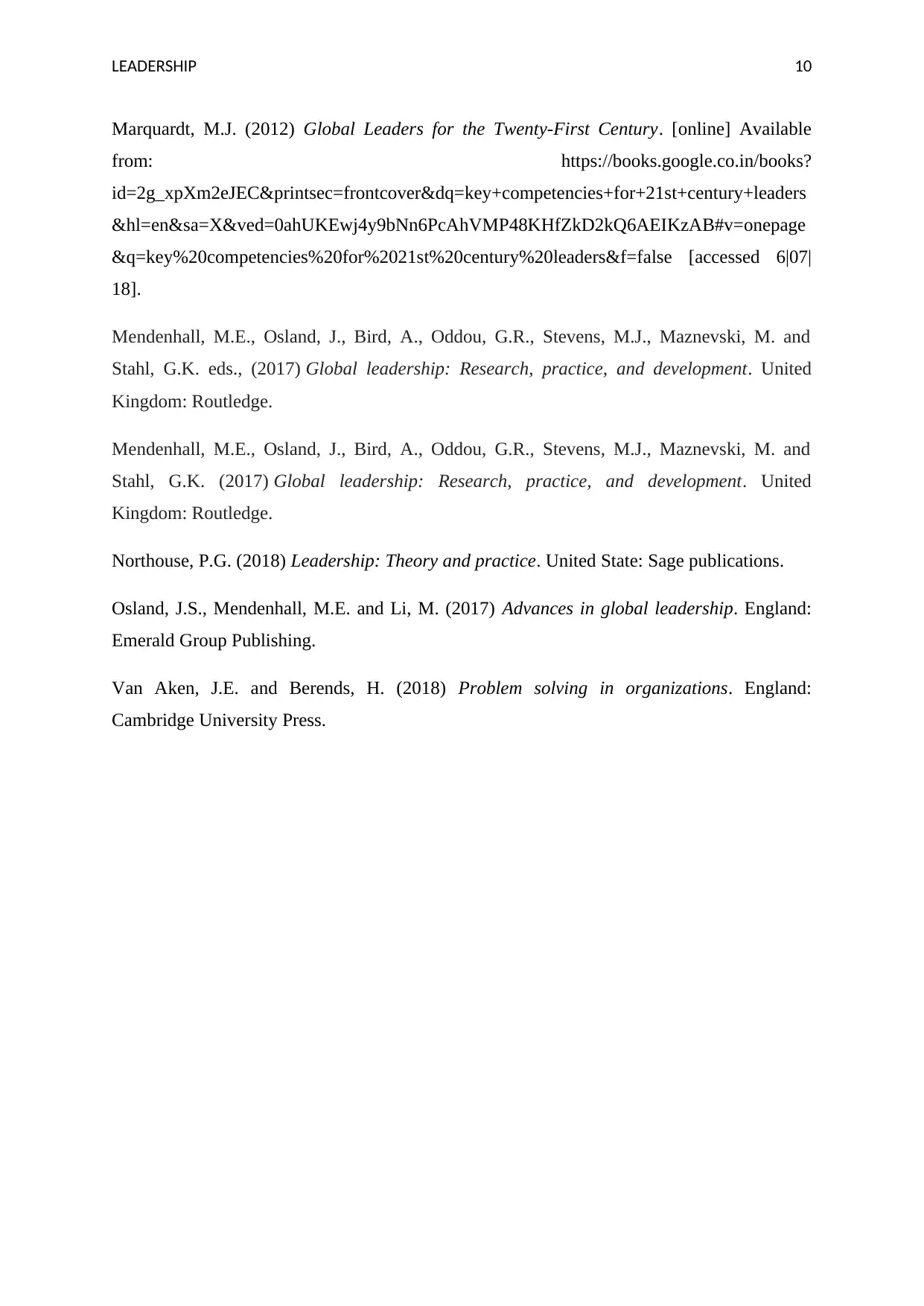
LEADERSHIP 10
Marquardt, M.J. (2012) Global Leaders for the Twenty-First Century. [online] Available
from: https://books.google.co.in/books?
id=2g_xpXm2eJEC&printsec=frontcover&dq=key+competencies+for+21st+century+leaders
&hl=en&sa=X&ved=0ahUKEwj4y9bNn6PcAhVMP48KHfZkD2kQ6AEIKzAB#v=onepage
&q=key%20competencies%20for%2021st%20century%20leaders&f=false [accessed 6|07|
18].
Mendenhall, M.E., Osland, J., Bird, A., Oddou, G.R., Stevens, M.J., Maznevski, M. and
Stahl, G.K. eds., (2017) Global leadership: Research, practice, and development. United
Kingdom: Routledge.
Mendenhall, M.E., Osland, J., Bird, A., Oddou, G.R., Stevens, M.J., Maznevski, M. and
Stahl, G.K. (2017) Global leadership: Research, practice, and development. United
Kingdom: Routledge.
Northouse, P.G. (2018) Leadership: Theory and practice. United State: Sage publications.
Osland, J.S., Mendenhall, M.E. and Li, M. (2017) Advances in global leadership. England:
Emerald Group Publishing.
Van Aken, J.E. and Berends, H. (2018) Problem solving in organizations. England:
Cambridge University Press.
Marquardt, M.J. (2012) Global Leaders for the Twenty-First Century. [online] Available
from: https://books.google.co.in/books?
id=2g_xpXm2eJEC&printsec=frontcover&dq=key+competencies+for+21st+century+leaders
&hl=en&sa=X&ved=0ahUKEwj4y9bNn6PcAhVMP48KHfZkD2kQ6AEIKzAB#v=onepage
&q=key%20competencies%20for%2021st%20century%20leaders&f=false [accessed 6|07|
18].
Mendenhall, M.E., Osland, J., Bird, A., Oddou, G.R., Stevens, M.J., Maznevski, M. and
Stahl, G.K. eds., (2017) Global leadership: Research, practice, and development. United
Kingdom: Routledge.
Mendenhall, M.E., Osland, J., Bird, A., Oddou, G.R., Stevens, M.J., Maznevski, M. and
Stahl, G.K. (2017) Global leadership: Research, practice, and development. United
Kingdom: Routledge.
Northouse, P.G. (2018) Leadership: Theory and practice. United State: Sage publications.
Osland, J.S., Mendenhall, M.E. and Li, M. (2017) Advances in global leadership. England:
Emerald Group Publishing.
Van Aken, J.E. and Berends, H. (2018) Problem solving in organizations. England:
Cambridge University Press.
1 out of 11
Related Documents
Your All-in-One AI-Powered Toolkit for Academic Success.
+13062052269
info@desklib.com
Available 24*7 on WhatsApp / Email
![[object Object]](/_next/static/media/star-bottom.7253800d.svg)
Unlock your academic potential
Copyright © 2020–2025 A2Z Services. All Rights Reserved. Developed and managed by ZUCOL.





